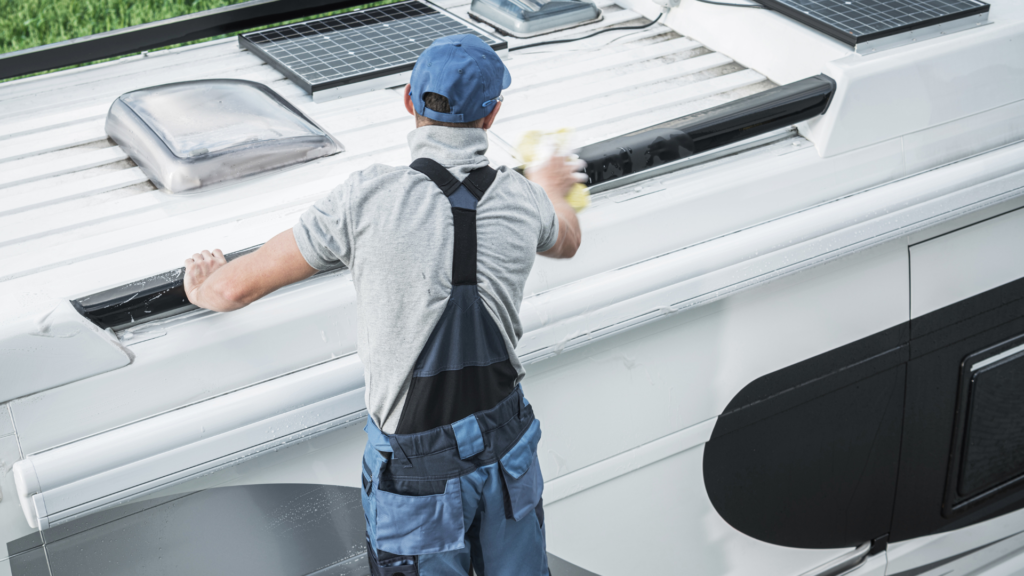For RV owners, outdoor enthusiasts, and travelers, ensuring proper RV roof maintenance and repair is essential to protecting your home on wheels from water damage. While maintaining your RV roof may seem challenging, having the right knowledge and tools makes it a manageable part of your routine. Using an RV roof maintenance kit can help simplify the process by providing the necessary materials for inspections, repairs, and protection. In this guide, we’ll explore key roofing tips, effective water damage prevention methods, and expert advice to keep your RV roof in top shape for years to come. By following these steps, you can maintain a safe, dry, and adventure-ready RV.
Common Types of RV Roofs
When it comes to RV roof maintenance, understanding the different types of RV roofs is essential. The most common types are rubber (EPDM or TPO), fiberglass, and aluminum. Each material has its own maintenance needs and potential issues.
EPDM (Ethylene Propylene Diene Monomer) roofs are popular for their durability and flexibility. They require regular cleaning and inspections for tears or punctures. TPO (Thermoplastic Olefin) roofs are also durable but need UV protection to avoid cracking.
Fiberglass roofs are sturdy and resistant to damage but can be heavy and prone to leaks if not properly maintained. Regular cleaning and sealing of joints are crucial for these roofs.
Aluminum roofs are lightweight and durable but can be noisy during rain and prone to denting. Regular inspections for signs of corrosion or damage are necessary to keep them in good condition.
Marathon saves you time and money to keep you moving, visit our website here .
Signs of Roof Damage
Recognizing the signs of roof damage early is key to effective RV water damage prevention. Some common signs to look out for include discoloration, bubbling, or soft spots on the ceiling. These can indicate water intrusion or mold growth.
Inspect the roof for visible cracks, tears, or punctures in the roofing material. Damaged or missing sealant around vents, skylights, and seams is another red flag. Also, check the interior walls and floors for any signs of moisture or water stains.
Sagging areas on the roof or ceiling may suggest structural damage and should be addressed immediately. Additionally, a musty odor inside the RV can signal hidden mold or mildew, often caused by roof leaks.
Essential RV Roofing Tips
Taking care of your RV roof doesn’t have to be overwhelming. Here are some essential RV roofing tips to keep your mobile home in top shape. First, schedule regular inspections. Check your roof at least twice a year and after any severe weather to catch potential issues early.
Second, clean your roof regularly. Use a gentle cleaner appropriate for your roof type to remove dirt, debris, and organic matter that can cause damage over time. A clean roof also makes it easier to spot any issues.
Third, maintain and replace seals and caulking. The seals around vents, skylights, and other openings can deteriorate over time, leading to leaks. Inspect these areas and reapply sealant as needed.
Lastly, consider investing in a UV protectant. This can extend the life of your roof by protecting it from sun damage. Following these RV roofing tips will help ensure your roof remains in excellent condition, providing you with a safe and dry living space.
Need quick assistance?? Our team of expert mechanics will arrive at your location in record time, call us !
Tools and Products for RV Roof Care
Having the right tools and products can make RV roof maintenance much easier. Start with a good ladder to safely access your roof. A soft-bristle brush will help you clean without causing damage. For cleaning, use an RV-specific roof cleaner suited to your roof type, whether it’s rubber, fiberglass, or aluminum.
Sealants and caulks are essential for maintaining a watertight roof. Choose a high-quality sealant designed for RV use to ensure long-lasting protection. UV protectant sprays are also valuable, offering a layer of defense against sun damage and extending the life of your roof.
For repairs, a patch kit compatible with your roof material can be a lifesaver. These kits typically include adhesive and patches for quick fixes. Lastly, consider investing in a cover to protect your RV when it’s not in use. A good cover shields your roof from the elements, reducing wear and tear.
RV Water Damage Prevention Strategies
Preventing water damage is crucial for maintaining the longevity of your RV. One of the best RV water damage prevention strategies is to conduct regular inspections. Look for any signs of leaks or damage, especially after heavy rain or snow.
Ensure that all seals and seams are intact. Deteriorating sealant around vents, skylights, and other roof openings can lead to leaks. Reapply sealant as needed to keep these areas watertight.
Ventilation is another key factor. Proper ventilation helps control humidity levels inside your RV, reducing the risk of mold and mildew. Use roof vents and fans to maintain airflow and prevent moisture buildup.
Additionally, park your RV in a shaded area or use a cover when it’s not in use. This protects the roof from the elements and reduces the risk of UV damage, which can degrade roofing materials and sealants over time.
Our team is 100% trained to help you and solve any problem. Contact us !
Long-Term RV Roof Protection
Ensuring long-term protection for your RV roof requires consistent care and proactive measures. Start by creating a maintenance schedule that includes regular inspections, cleanings, and resealing tasks. This will help you catch and address minor issues before they become major problems.
Investing in a high-quality RV cover can significantly extend the life of your roof. A good cover protects your RV from harmful UV rays, rain, snow, and debris, reducing wear and tear. Additionally, consider using a UV protectant spray on your roof to minimize sun damage.
Parking your RV in a shaded area or under a shelter when not in use can further protect it from the elements. This helps prevent the roofing material from degrading over time due to constant exposure to harsh weather conditions.
Lastly, stay informed about new products and techniques for RV roof care. Advances in materials and maintenance methods can offer better solutions for protecting your RV roof in the long run. By taking these steps, you can ensure your RV roof remains durable and reliable for years to come.
If you Learn more about RV Roof Maintenance then you can visit our Google My Business Profile.
Call us for truck repair road service here . We are in Florida, Texas and Georgia. Open 24/7.




